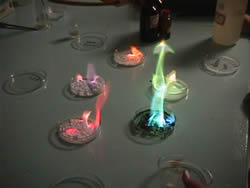When it comes to light, different elements can emit different colors. For example, sodium will emit a yellow light, while mercury will emit a blue light. There are many factors that contribute to why these different elements produce varying colors.
One reason has to do with the energy levels of the element’s electrons. Different atomic structures will absorb and release different amounts of energy, which in turn affects the wavelength and color of the emitted light. Additionally, some elements may have more than one electron shell, causing them to emit multiple colors of light.
Finally, certain impurities or defects in an element’s structure can also cause it to produce unique colors.
Different elements emit different colors because of their unique atomic structures. When an element is heated, it produces light at a certain wavelength that is determined by the energy levels of its electrons. The higher the energy levels, the shorter the wavelength and the more blue the light appears.
The lower the energy levels, the longer the wavelength and the more red the light appears.

Credit: www.webexhibits.org
What Causes Different Elements to Emit Different Colors
Different elements emit different colors because of the way their atoms are structured. Atoms are made up of protons and electrons, and the number of protons in an atom’s nucleus determines what element it is. The electrons in an atom orbit the nucleus at different levels, called energy levels or shells.
When an electron jumps from one shell to another, it releases a photon, which is a particle of light. The color of that photon depends on how much energy the electron releases when it makes the jump.
How Does the Color Emitted by an Element Depend on Its Atomic Structure
When an element is heated, it produces light. The color of this light depends on the element’s atomic structure. Each element has a unique atomic structure, which includes a certain number of protons in its nucleus.
The number of protons in an element’s nucleus determines the element’s identity. For example, hydrogen has one proton in its nucleus, while helium has two protons.
The colors emitted by an element also depend on the energy levels of its electrons.
Electrons orbit the nucleus at different energy levels, or shells. When an electron jumps from a lower energy level to a higher energy level, it releases a photon, or particle of light. The photon’s wavelength corresponds to the amount of energy released in the jump.
Different elements have different numbers of protons in their nuclei, and thus emit different colors of light when heated.
What Determines the Particular Color That an Element Will Emit
When an element is heated, the electrons in the outermost energy level are excited and move to a higher energy level. As these electrons relax back down to their original energy levels, they release photons – particles of light. The particular color that is emitted depends on the difference in energy between the two levels.
The greater the difference, the higher the frequency of the photons (and the shorter their wavelength), and so the more blue or violet light is emitted. For example, when sodium atoms are heated they emit yellow light, because there’s only a small difference in energy between their ground state and first excited state.
Why Do Different Elements Emit Different Wavelengths of Light
Different elements emit different wavelengths of light because they have different amounts of energy. The amount of energy an element has is determined by its atomic number. The higher the atomic number, the more energy the element has.
This extra energy is what causes the element to emit light at a shorter wavelength than other elements.
Conclusion
Different elements emit different colors because of the way their electrons are arranged. Electrons orbit the nucleus of an atom in shells. When an element is heated, the electrons in the outermost shell become excited and jump to a higher energy level.
As they fall back down to their original energy level, they emit photons, which are particles of light. The color of light emitted depends on the amount of energy emitted, with lower energies corresponding to redder light and higher energies corresponding to bluer light.
